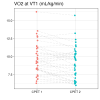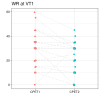Andy
Senior Member (Voting rights)
Full title: Submaximal 2-day cardiopulmonary exercise testing to assess exercise capacity and post-exertional symptom exacerbation in people with long COVID.
Sixty-eight people (age (mean ± SD): 50 ± 11 years, 46 females (68%)) were screened for severity of PESE and completed two submaximal cardiopulmonary exercise tests separated by 24 h. Work rate was stratified relative to functional status and was set at 10, 20 or 30 W, increasing by 5 W/min for a maximum of 12 min.
At the first ventilatory threshold (VT1), V̇O2 was 0.73 ± 0.16 L/min on Day 1 and decreased on Day 2 (0.68 ± 0.16 L/min; P = 0.003). Work rate at VT1 was lower on Day 2 (Day 1 vs. Day 2; 28 ± 13 vs. 24 ± 12 W; P = 0.004). Oxygen pulse on Day 1 at VT1 was 8.2 ± 2.2 mL/beat and was reduced on Day 2 (7.5 ± 1.8 mL/beat; P = 0.002). The partial pressure of end tidal carbon dioxide was reduced on Day 2 (Day 1 vs. Day 2; 38 ± 3.8 vs. 37 ± 3.2 mmHg; P = 0.010). Impaired V̇O2 is indicative of reduced transport and/or utilisation of oxygen. V̇O2 at VT1 was impaired on Day 2, highlighting worsened function in the 24 h after submaximal exercise. The data suggest multiple contributing physiological mechanisms across different systems and further research is needed to investigate these areas.
Open access
Abstract
Long COVID has a complex pathology and a heterogeneous symptom profile that impacts quality of life and functional status. Post-exertional symptom exacerbation (PESE) affects one-third of people living with long COVID, but the physiological basis of impaired physical function remains poorly understood.Sixty-eight people (age (mean ± SD): 50 ± 11 years, 46 females (68%)) were screened for severity of PESE and completed two submaximal cardiopulmonary exercise tests separated by 24 h. Work rate was stratified relative to functional status and was set at 10, 20 or 30 W, increasing by 5 W/min for a maximum of 12 min.
At the first ventilatory threshold (VT1), V̇O2 was 0.73 ± 0.16 L/min on Day 1 and decreased on Day 2 (0.68 ± 0.16 L/min; P = 0.003). Work rate at VT1 was lower on Day 2 (Day 1 vs. Day 2; 28 ± 13 vs. 24 ± 12 W; P = 0.004). Oxygen pulse on Day 1 at VT1 was 8.2 ± 2.2 mL/beat and was reduced on Day 2 (7.5 ± 1.8 mL/beat; P = 0.002). The partial pressure of end tidal carbon dioxide was reduced on Day 2 (Day 1 vs. Day 2; 38 ± 3.8 vs. 37 ± 3.2 mmHg; P = 0.010). Impaired V̇O2 is indicative of reduced transport and/or utilisation of oxygen. V̇O2 at VT1 was impaired on Day 2, highlighting worsened function in the 24 h after submaximal exercise. The data suggest multiple contributing physiological mechanisms across different systems and further research is needed to investigate these areas.
Highlights
- What is the central question of this study?
Can a submaximal 2-day cardiopulmonary exercise test (CPET) protocol suggest why people living with long COVID experience post-exertional symptom exacerbation (PESE)? - What is the main finding and its importance?
A submaximal 2-day CPET protocol revealed a reduction in oxygen uptake, oxygen pulse and partial pressure of end tidal carbon dioxide, suggesting dysfunctional oxygen transport, utilisation or both may contribute to long COVID PESE. Provided that there are appropriate and detailed screening processes that exclude people living with moderate–severe-risk post-exertional malaise, submaximal CPET offers a safe and informative option to investigate long COVID pathophysiology.
Open access


